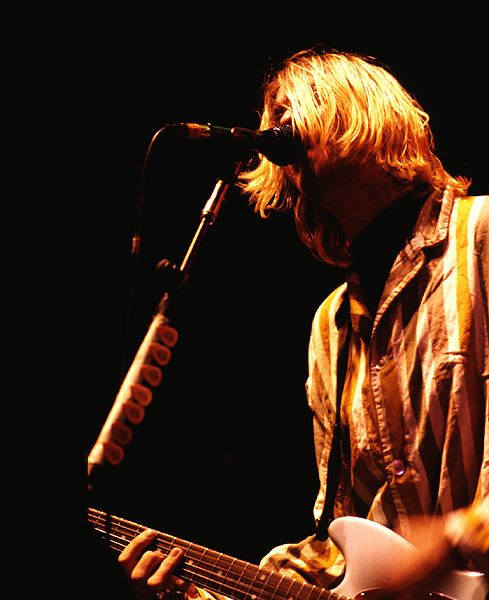|
|
|
 |
|
|
Much
has been written about the events of April 8th, 1994 - the day Kurt Cobain's
body was discovered in the garage of his home - and, for the thousands
of Nirvana fans left behind, that day will remain in their memory for many
years to come. Cynics have claimed that Cobain tried to make himself a
"rock and roll martyr" by taking his own life - an attempt to secure the
reputation as the Jim Morrison of the nineties - but such speculation tends
to overlook the terrible tragedy of the death of one of the most influential
artists of this decade. Such statements are stupid and insensitive.
To
this day there is uncertainty surrounding the death of James Morrison,
with this very uncertainty perpetuating the legend of his martyrdom - his
attempt to "break on through to the other side." In fact there are those
who maintain he never died, but instead feigned his own death and escaped
the pressures of his lifestyle to live out his remaining days anonymously.
There are no such uncertainties surrounding the death of Kurt Cobain. He
was found in his garage, having been dead for some time from a single,
self-administered shotgun blast to the head. Around him were some tapes,
a computer game, a hand-written suicide note, and a cuddly toy. He was
positively identified from his fingerprints.
Kurt
Cobain had grown up in small-town Aberdeen, Washington, "like Twin Peaks
without the excitement". His happy childhood was shattered forever at the
age of eight with the rancorous separation of his parents. The sudden and
unexpected success of Nirvana, with their Nevermind album selling in excess
of ten million copies world-wide, gave Kurt Cobain the place as one of
the spokesmen for a generation. Their music opened the way for countless
other "underground" bands, but brought the inevitable barrage of media
attention, picking his life apart, carving him open and laying his innards
out for all to see. Kurt had suffered from a rare illness for almost seven
years, causing a chronic stomach pain of such an intensity that almost
every day he considered killing himself. This constant severe pain led
to a deep melancholic depression verging on schizophrenia, and frequent
bouts of narcoplepsy. None of the doctors he visited were of any help,
but the money he made from Nirvana offered him a temporary release to the
pain - through heroin. Soon the heroin took over, and although he tried
to kick the habit on numerous occasions, the stomach pains returned with
such an intensity that even the heroin appeared to be a better alternative.
His
undoubted love and devotion for his wife, Courtney Love, and his daughter
Frances, brought the first real happiness and hope into his life for many
years, but the constant media attention, and increasingly frequent bouts
of depression finally drove him to the edge. There will surely be much
speculation as to what finally caused him to crack, but one thing can be
said for certain - this was no "rock and roll martyrdom", but rather the
tragic waste of a creative life. The pressures which brought Kurt Cobain
to the point of ending his life were supremely human and not explained
simply as the result of a "degenerate" lifestyle. The tears he cried were
as valid as the tears of any other human being, the pain he felt was just
as real and as justified as any pain ever was, and the tragic actions he
took were the only solution he could find.
Around
the Cobain home, on the morning Kurt's body was found, dew would have fallen.
The sun would have risen on a new day, the air would be filled with the
sounds of the morning, yet, within the house, Cobain's body lay as silent
witness to the pain and emptiness that typifies the human condition. Looking
at a famous photograph of Kurt taken after a concert in 1991, I see a distraught
young man wrestling with forces inside him which he cannot understand or
control. There are no rock dramatics about this young man, nor is there
any of the craziness which permeated his work and his lifestyle.
There
is merely a terrified, lonely individual, and I weep for him,
R.I.P.
Kurt Cobain.
|
|
|
|
|
|
|